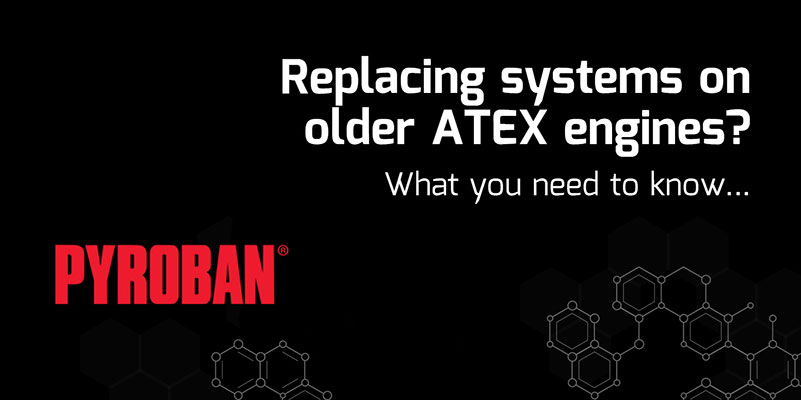Temporary well service equipment is subjected to arduous environmental conditions during its working life and machines are often refurbished to extend the assets’ life cycle. In these changing times in the oil and gas markets, high quality refurbishment is becoming a critical part of the operator’s playbook, to keep cost effective equipment available for their clients. Here’s what you need to know when replacing parts on the ATEX engine.
Most businesses refurbishing explosion proof engines will use approved components from the original manufacturer, such as Pyroban. This helps maintain the integrity of the safety systems and validity of the ATEX compliance to the original designs (assuming the installation is completed by a competent person).
In these cases, the system will not need further testing, although an independent safety inspection audit is advised following any major works.
What if you use another manufacturer for components and systems?
Under ATEX requirements inlet and exhaust components must be tested as a system to ensure that they pass flame non-transmission testing described in EN1834. Pyroban kits are tested to ensure compliance at the factory.
However, when using different OEM components, the original compliance can’t be assumed, and businesses must follow certain rules to ensure complete safety and integrity of the “new” system created. For example, when Pyroban quotes to replace and update an explosion proof engine originally protected by another Ex brand we will complete the appropriate flame non-transmission testing to verify the new configuration is safe for use.
Flame non-transmission testing refers to the testing of Ex d flameproof “enclosures” which are used on ATEX diesel engines including in the inlet and exhaust systems. For engines, the enclosure is the complete system from the engine to the appropriate flame arrestor. The system should contain an explosion (mechanical strength) and stop any flames escaping into the surrounding atmosphere, should an internal explosion occur through the effectiveness of the flame arrestor.
The effectiveness of the flame arrestor is extremely important and any deviation in the new design could allow flames to be released into the surrounding explosive mixture. Therefore, the safety integrity of the new design must be proven.
What are the rules for modifications/refurbishments of Ex d equipment?
Any product featuring Ex d enclosures should follow EN / IEC 60079-0 (general requirements) and in EN / IEC 60079-1 for the “flameproof” type of ignition protection and EN 1834-1 for engine protection requirements.
In simple terms, there is a requirement for testing flameproof enclosures to ensure that there is no transmission of an internal explosion. Inlet and exhaust system included.
This means where there is significant modification to the design (i.e a new part by a different manufacturer), the manufacturer of the flameproof system has to conduct flame non-transmission testing in order to comply with the relevant standards and ATEX 2014/34/EU.
No test, no proven compliance!
So what is flame non-transmission testing?
The Ex d enclosure is filled with a defined flammable gas/air mixture and ignited. The test must prove that the flame cannot reach the atmosphere, which is also filled with the same explosive mixture. The test is repeated ten times to ensure consistent performance and that the enclosure has not suffered mechanical failure or distortion due to the high explosion pressures sustained.
Pyroban has its own onsite flame non-transmission testing
Pyroban is unique because we have onsite testing facilities at the manufacturing plant in Shoreham by Sea, West Sussex, UK. This means that we can perform all tests according to the standards without having to wait for a testing house to do it for us or skipping this step (which we believe may be the case for some manufacturers who assume the system still meets the requirements with alternative parts).
Our testing process involves purging and igniting the enclosures the required ten times and using high speed cameras and other technology to prove the design is in accordance with the standards.
What supplier would you use?
In the case of spare parts and refurbishments, Pyroban believes that it is always best to use the OEM manufacturer so that the certification and design remains as intended. We have many heritage parts available (parts@pyroban.com) and where a manufacturer has gone out of business or is no longer actively supplying spares, Pyroban will re-test the “mixed brand” hybrid system to ensure safety.
All manufacturers should be able to provide this important evidence that the new Ex d enclosure, inlet, or exhaust system will perform as intended.
If not, then questions should be asked as to the quality of the system and subsequent safety of the equipment in operation. That’s why we invested in our on-site facility many years ago so we can supply new solutions in short lead times and with the integrity and evidence to support the final certificate that you expect from Pyroban.
For more information on this subject, contact our technical team on +44 (0) 1273 456800 or info@pyroban.com.
To book a safety audit following the completion of refurbishment works, click here.

